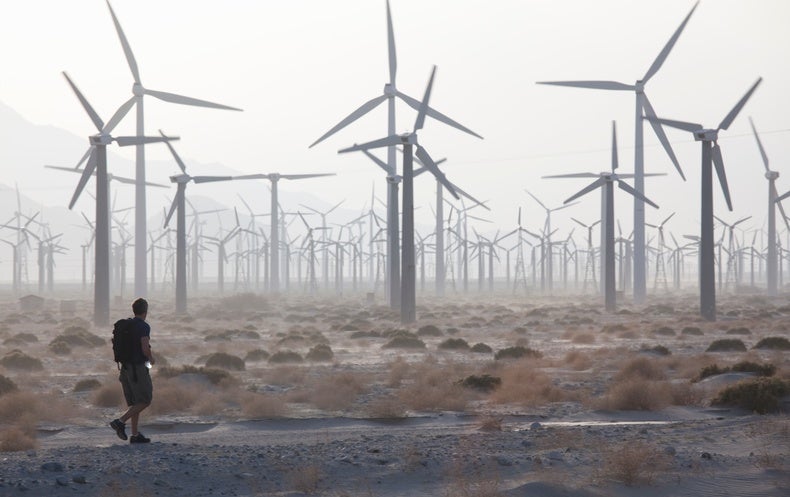The blades of a wind turbine are typically designed to be replaced about every 20 years. This means that, as wind energy becomes more popular, more and more of these hulking fiberglass structures will be discarded, and many of them could end up buried in the ground. To encourage recycling the blades instead, one research team has developed a binding resin—the ingredient that holds their fibrous material together—that can be transformed into more valuable substances.
“We’ve specifically designed a system with the end of life in mind,” says John Dorgan, a professor of chemical engineering and materials science at Michigan State University, who worked on developing the new resin. After being used for years to strengthen wind turbine blades or other structures, the resin can be recycled back into another turbine blade or downcycled into a composite material that can be used to make plastic products. It can also be processed to produce more valuable chemicals: these upcycled options include the shatter-resistant acrylic plexiglass, a superabsorbent polymer used in diapers and the food preservative potassium lactate—which Dorgan used to make gummy bears that he then ate.
Wind turbine blades are typically 170 feet long, roughly the length of an Olympic-sized swimming pool. But because bigger turbines can capture more energy, some offshore wind farms are investing in taller installations that can sport blades nearly twice as long. When these massive blades are damaged or reach the end of their lifetime, they must be retired from use. By 2050, experts estimate that more than two million tons of blade material could be decommissioned each year.
There are two main obstacles to recycling these structures. “To start with is just the fact that they’re very large, and they’re meant to be very durable—to last in the weather for 20 or more years. So they’re just a hard thing to disassemble and move around,” explains Aubryn Cooperman, a wind energy analyst at the National Renewable Energy Laboratory, who was not involved in the new resin’s development. Another problem “is that they’re made from materials that are as low-cost as possible [that will] still get the performance you need.” For maximum efficiency, wind turbine blades must be both light and strong, so engineers typically craft them from fiberglass bonded together with a polymer resin. In theory, this material can be recycled, but researchers say the resulting product is not particularly valuable. “The main problem is: it’s simply uneconomic to do it,” Dorgan says. “It’s cheaper to just bury it in the ground than it is to reprocess it into something useful.”
To solve this problem, recycling wind turbine blades must become easier and more profitable. Several companies in the renewable energy industry—including Siemens Gamesa, General Electric and Vestas—are working on this issue, Cooperman says. “Anything that makes it easy to recycle, that makes it less costly to recycle, increases the chances of more recycling happening,” she notes.
Dorgan and his colleagues decided to develop a new polymer resin that could bind a large fiberglass structure firmly together while it is in use and that could be turned into a variety of products when the time comes to retire the blade. The team produced a syrupy resin by dissolving polylactide, a polymer derived from plants, in a synthetic monomer called methyl methacrylate (MMA). Next, the researchers used vacuum pressure to pull the resin through glass fibers. After the fibers had been impregnated with the liquid, the resin hardened, producing solid fiberglass panels. The same process can be used to make larger structures, including wind turbine blades and boat hulls. The team presented the work this week at a meeting of the American Chemical Society.
When the time came to recycle their experimental fiberglass panels, the researchers had a few options. In one, they could crush up the panels and add an additional polymer, producing a plastic material that could be transformed into other objects through injection molding. This short-fiber composite might become the basis of computer housings or other objects but would not be particularly valuable, Dorgan says. Another option was to make strong new panels from the remains of the old ones: the team soaked the panels in the MMA monomer, which dissolved the hardened resin—then the researchers physically removed the glass fibers. The recovered “syrup” was used to make fresh fiberglass panels, which had the same physical properties as the originals.
But the leftover resin also has other potential uses. “What would really drive recycling of wind turbines is if you could turn them into something that’s worth more money or by using it to [make high-value] products out of it,” Dorgan says. For instance, putting the recovered resin through different chemical reactions allowed the team to extract new compounds. One substance produced this way was polymethyl methacrylate, an acrylic polymer better known as plexiglass. This transparent, shatter-proof substance is valued as an alternative to glass in a vast variety of goods, ranging from windows to car headlights. Cooking the resin at a high temperature produced poly(methacrylic acid), a superabsorbent material used in diapers and other products. A little more processing resulted in potassium lactate, which is added to a variety of foods as a preservative. Although Dorgan did use it to make his own version of gummy bears, he does not necessarily see homemade candy as the primary way to improve the recyclability of wind turbine blades. His goal is to encourage recycling by changing attitudes.
“I’m trying to push the boundaries of how people think about recycling,” he explains. “It’s about creating additional options and getting people to think about ‘What really are the limits on recycling?’ And as far as I know, nobody’s ever reprocessed a durable composite material into something that can be eaten.”
































